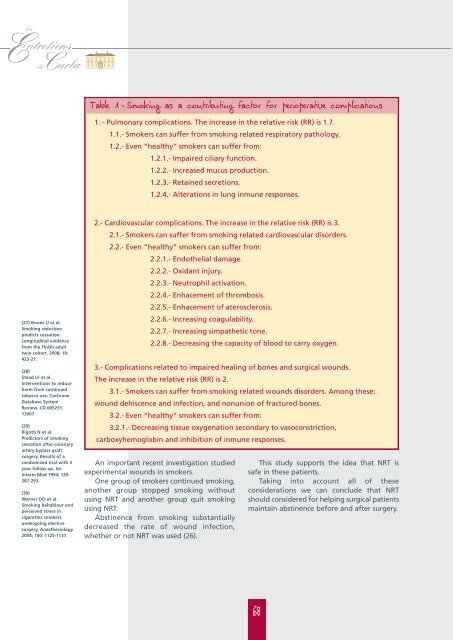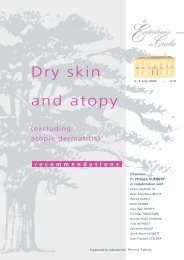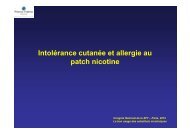Nicotine replacement therapy … - Carlos A ... - Entretiens du Carla
Nicotine replacement therapy … - Carlos A ... - Entretiens du Carla
Nicotine replacement therapy … - Carlos A ... - Entretiens du Carla
You also want an ePaper? Increase the reach of your titles
YUMPU automatically turns print PDFs into web optimized ePapers that Google loves.
(27) Broms U et al.<br />
Smoking re<strong>du</strong>ction<br />
predicts cessation.<br />
Longitudinal evidence<br />
from the Finish a<strong>du</strong>lt<br />
twin cohort. 2008; 10:<br />
423-27.<br />
(28)<br />
Stead LF et al.<br />
Interventions to re<strong>du</strong>ce<br />
harm from continued<br />
tobacco use. Cochrane<br />
Database System<br />
Review. CD 005231.<br />
12007.<br />
(29)<br />
Rigotti N et al.<br />
Predictors of smoking<br />
cessation after coronary<br />
artery bypass graft<br />
surgery. Results of a<br />
randomized trial with 5<br />
year follow up. An<br />
Interm Med 1994; 120:<br />
287-293.<br />
(30)<br />
Warner DO et al.<br />
Smoking behabiour and<br />
perceived stress in<br />
cigarettes smokers<br />
undergoing elective<br />
surgery. Anesthesiology<br />
2004; 100: 1125-1137.<br />
Table 1-Smoking as a contributing factor for perioperative complications<br />
1. - Pulmonary complications. The increase in the relative risk (RR) is 1.7.<br />
1.1.- Smokers can suffer from smoking related respiratory pathology.<br />
1.2.- Even “healthy” smokers can suffer from:<br />
1.2.1.- Impaired ciliary function.<br />
1.2.2.- Increased mucus pro<strong>du</strong>ction.<br />
1.2.3.- Retained secretions.<br />
1.2.4.- Alterations in lung inmune responses.<br />
2.- Cardiovascular complications. The increase in the relative risk (RR) is 3.<br />
2.1.- Smokers can suffer from smoking related cardiovascular disorders.<br />
2.2.- Even “healthy” smokers can suffer from:<br />
2.2.1.- Endothelial damage.<br />
2.2.2.- Oxidant injury.<br />
2.2.3.- Neutrophil activation.<br />
2.2.4.- Enhacement of thrombosis.<br />
2.2.5.- Enhacement of aterosclerosis.<br />
2.2.6.- Increasing coagulability.<br />
2.2.7.- Increasing simpathetic tone.<br />
2.2.8.- Decreasing the capacity of blood to carry oxygen.<br />
3.- Complications related to impaired healing of bones and surgical wounds.<br />
The increase in the relative risk (RR) is 2.<br />
3.1.- Smokers can suffer from smoking related wounds disorders. Among these:<br />
wound dehiscence and infection, and nonunion of fractured bones.<br />
3.2.- Even “healthy” smokers can suffer from:<br />
3.2.1.- Decreasing tissue oxygenation secondary to vasoconstriction,<br />
carboxyhemoglobin and inhibition of inmune responses.<br />
An important recent investigation studied<br />
experimental wounds in smokers.<br />
One group of smokers continued smoking,<br />
another group stopped smoking without<br />
using NRT and another group quit smoking<br />
using NRT.<br />
Abstinence from smoking substantially<br />
decreased the rate of wound infection,<br />
whether or not NRT was used (26).<br />
This study supports the idea that NRT is<br />
safe in these patients.<br />
Taking into account all of these<br />
considerations we can conclude that NRT<br />
should considered for helping surgical patients<br />
maintain abstinence before and after surgery.<br />
68






